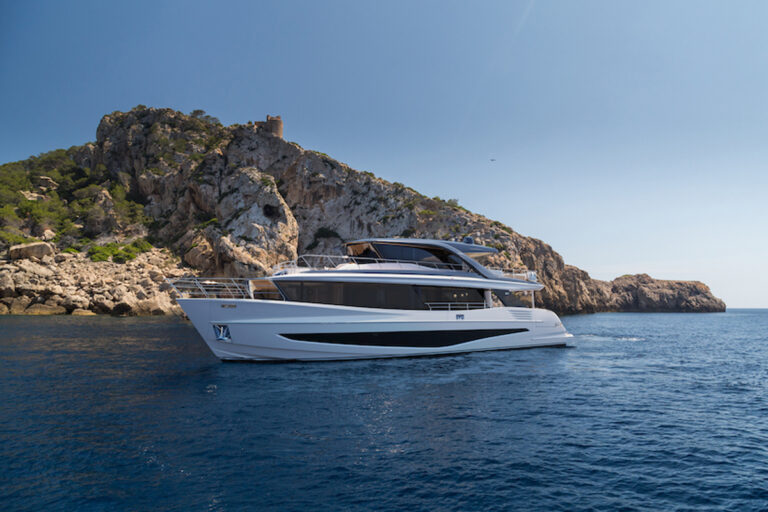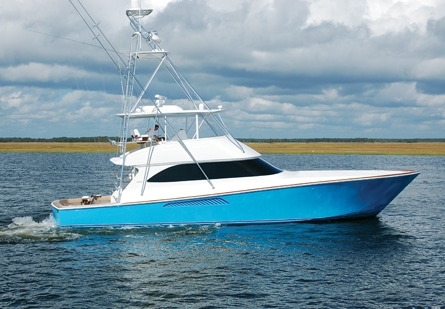
viking60conv445.jpg
The wind was down a bit, from a sustained 35 knots from the northeast to a mere 25-knot easterly as we climbed aboard at dawn. On this kind of day, tournament fishermen would choose either to venture to where the fish were, or stay close to the inlet and hope for a bite. Fun fishing would be decided by one’s definition of fun. And either decision would have a lot to do with the boat.
Of course the boat, Viking’s new 60 convertible, was our reason for being on the water. I wanted to see how it handled and fished in less than ideal conditions. As the inlet came into view, solid eightfooters breaking across its mouth had me wondering if we’d gotten a bit more than we bargained for. I found out soon enough, though, that we hadn’t, as skipper Ryan Higgins pushed the throttles up and negotiated the ugly inlet at 18 to 20 knots with ease.
Many consider 60 feet the perfect size for a sportfisherman- retaining the agility needed to spin on a hot fish, or two, while providing enough room for either three or four staterooms, a spacious saloon and galley, a roomy cockpit, and plenty of seating on the bridge. As expected, Viking retained these features from their venerable 61, built from 2001 to 2006, but this new 60 is far more than an updated 61.
I’d been aboard the boat a few weeks earlier for the sea trial (in more reasonable conditions). I tried to ask questions comparing it to the 61, a boat known to raise fish and handle rough seas beautifully, but Pete Frederiksen, Viking’s communication director, wouldn’t bite. “Every model that Viking builds is a brand-new boat. This 60 has a different style, a different look, and a different hull shape,” Frederiksen said. “We use these boats, and we find out what works and what doesn’t.”
In fact, this 60 is not only a completely different boat from its predecessor, it is the first model of a markedly new look for Viking. A similarly styled 50 debuted in February at the 2008 Miami International Boat Show, and an 82 is on the horizon for 2009. The most noticeable change is the elimination of Viking’s until-now trademark dropped bow. The higher sheerline at the bow also comes with a more aggressively raked stem, as well as a bit more camber in the foredeck. The lines of the bridge, cabin, and windows are more graceful too, and with the prototype boat’s teak cap rail and covering boards, and its uncluttered foredeck, this new 60 has all the dock appeal of the sexiest custom boat.
Much of the boat’s custom look actually stems from practical considerations. The curved transom, for example, backs better into a sea, and also eases the problem of rods in the fighting chair gimbal reaching all the way around the stern of the boat. Other details, like recesses molded into the cabin front to make the black mask catch the eye better than just a paint line, are purely for looks. Subtle refinements continue inside, with just a bit more teak millwork than in previous Vikings. In short, I’d have to say Viking has taken its already high standards up a notch.
Improvements go deeper than aesthetics. As we ventured out the inlet, Higgins knew fishing had been good. He could have stayed close to the inlet and we would have caught fish, but he was headed south where he thought we’d see the best action-without compromising for the weather. Riding in six- and seven-footers, with a fair number of eights in the mix, Higgins had to occasionally pull the throttles back for large or steep waves, but we cruised the ten miles or so south averaging around 25 knots in astonishing comfort.
The boat’s ride was no accident. Higgins explained that Viking shifted weight aft and changed the running angle. (It helps that engines have become lighter for a given horsepower.) They also flattened the after sections of the hull a bit, and made forward sections slightly convex, instead of the 61’s slightly concave hull. These changes combine to allow the bow to rise and fall more gently, and also make the wake break farther aft, for a drier ride.
Viking made some changes in the layout, as well. On the flying bridge, for example, a center island is flanked by a long bench seat and walkway to port and starboard, with a forward-facing bench seat in front of the helm. Viking opted for three teak ladder-back chairs, one for the captain and one on either side. As one would expect, the Palm Beach-style helm features single-lever controls and power steering, and the console includes room for three 16-inch navigation displays plus a host of additional electronics, all behind acrylic doors so they can be seen without being exposed to salt air. The bridge also includes a chest freezer, a drink box, plenty of stowage and a freshwater washdown.
At the front of the cockpit, a mezzanine provides shaded seating. Hatches in the mezzanine seat and deck conceal a freezer, a refrigerated drink box and an optional refrigerated bait box, as well as engineroom access. A four-drawer tackle center on the port side sits beneath the ladder from the bridge. Under the gunwales, Viking has included gaff, tag stick, or brush handle stowage, as well as the usual washdown spigots and shorepower and utility receptacles. On the boat I was aboard there was a fish box running fore-and-aft on the port side beneath the cockpit sole, and a baitwell and storage bin on the starboard side. These can be configured to the purchaser’s request. (On this demo-boat, Viking opted to forego the transom livewell, and specified a marlin door, but not a hinged covering board.)
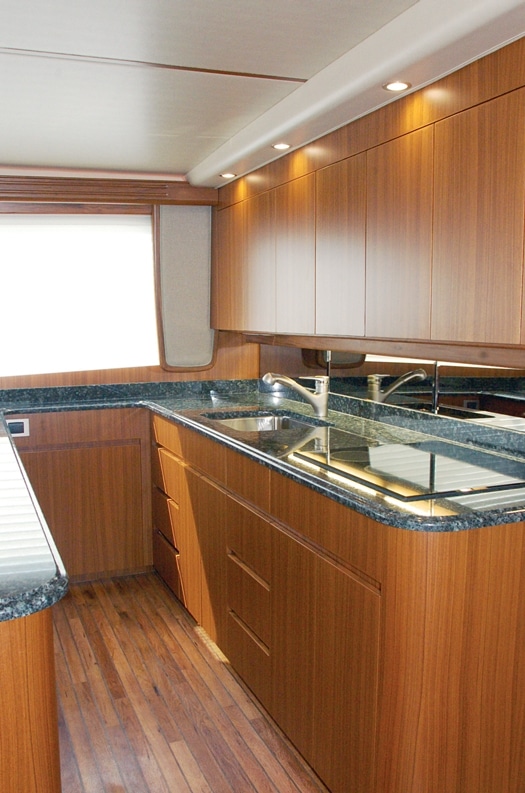
| | |
In the saloon, the settee is aft and the dinette forward on the starboard side, with a U-shape galley forward on the port side. This creates an open feeling, and allows room for barstools abaft the galley counter. The galley has under-counter refrigerator and freezer drawers, for easy access while under way, as well as a microwave, a trash compactor, and sufficient stowage, all concealed behind teak cabinetry, with a stove and sink mounted in the granite countertop. Cabinets in the saloon provide more stowage and conceal the entertainment center. The 42-inch LCD television is mounted on the forward bulkhead, above the dinette.
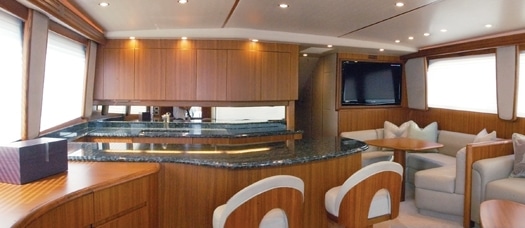
| | |
Descending a short flight of stairs between the galley and dinette is the master stateroom to port. It features a queen-size berth set diagonally, which gives the already roomy stateroom the impression of even more space. A large hanging locker, chest of drawers, dresser, and nightstands provide enough stowage for a couple to stock up for some extended island cruising. The four stateroom-layout is similar, but it has less floor space and a smaller hanging locker in the master.
The stateroom in the bow offers either an island queen, or a double berth on the starboard side, plus a single berth higher and to port. You’ll find more than enough space in the drawers and lockers. The en suite head sits to starboard on the three-stateroom layout, but moves across to port and loses a bit of space with four staterooms. The starboard after stateroom features side-by-side twin berths, with this head and shower accessible from within the stateroom or from the hallway.
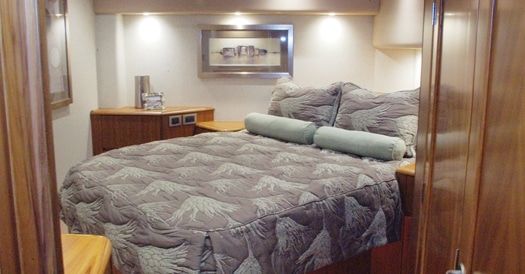
| | |
As has long been the case with Vikings, most mechanical equipment is in the engineroom. Even with the optional 1,825-hp Caterpillar C32A diesels, there is plenty of room to access equipment, and Viking includes thoughtful features to make maintenance easier, such as remote engine start buttons right next to the fuel system priming pumps and a hose connection for the engine oil change system in the cockpit. New aboard the 60, the Moritz OctoPlex system monitors and controls shipboard AC/DC power with touchscreen panels in the saloon and on the flying bridge and manual backup breakers in the engineroom. This saves the space of a large electrical panel in the saloon, as well as the weight of additional wires to feed it (about 800 pounds).
With the big Cats, performance of the 60 was quite impressive. During my sea trial off Palm Beach in two- to three-foot seas, with a full tuna tower and 900 gallons of fuel aboard, we reached 41.6 knots at maximum throttle, and at 2100 rpm cruised at 37.6 knots, burning 121.9 gallons per hour.
As for the boat’s fishing capabilities, we caught nine of 12 sailfish that day, tying the boat’s best day to date. I dragged the crew’s average down, unfortunately-turning only two of my four strikes into releases, with one pulling the hooks a few feet from the boat, and the other lost shortly after hookup. Mate Rhett Bailey pitched a bait to a sailfish while I was fighting one of mine, for the ninth release. But I’m pretty certain that my mediocre performance is not the only reason I’m left yearning for another trip on the Viking 60.
Contact: Viking Yachts, (609) 296-6000, www.vikingyachts.com.








